ČECHY / BÖHMEN
Bohemia

|
Monarchy |
|||||||||
|
The Lands
of the Bohemian Crown, often called Czech lands in modern times, were a
number of incorporated states in Central Europe during the medieval and early
modern periods connected by feudal relations under the joint rule of the
Bohemian kings. The crown lands primarily consisted of the Kingdom of
Bohemia, an electorate of the Holy Roman Empire according to the Golden Bull
of 1356, the Margraviate of Moravia, the Duchies of Silesia, and the
Lusatias, as well as other territories throughout its history. The joint
rule of Corona regni Bohemiae was
legally established by decree of the Bohemian king Charles IV of Luxembourg
issued on 7 April 1348, on the foundation of the original Czech lands ruled
by the Přemyslid dynasty until 1306. By linking the territories, the
interconnection of crown lands thus no more belonged to a king or a dynasty
but to the Bohemian monarchy itself, symbolically personalized by the Crown
of Saint Wenceslas. Under the rule of Ferdinand I from 1526, the lands of the
Boheman Crown became a constituent part of the Habsburg Monarchy. Later they
passed to the Austrian Empire and the Cisleithanian half of Austria-Hungary.
By the Czechoslovak declaration of independence in 1918, the remaining Czech
lands became part of the First Czechoslovak Republic. The
Bohemian Crown was neither a personal union nor a federation of equal
members. Rather, the Kingdom of Bohemia had a higher status than the other
incorporated constituent countries. There were only some common state
institutions of the Bohemian Crown and they didn't survive the centralization
of the Habsburg Monarchy under Empress Maria Theresa in the 18th century. The
most important of them was the Bohemian Court Chancellery which was united
with the Austrian Chancellery in 1749. In a
historical context, Czech texts use the term to refer to any territory ruled
by the Kings of Bohemia, i.e., the lands of the Bohemian Crown (země Koruny české) as
established by Emperor Charles IV in the 14th century. This would include
territories like the Lusatias (which in 1635 fell to Saxony) and the whole of
Silesia, all ruled from Prague Castle at that time. After the conquest of
Silesia by the Prussian king Frederick the Great in 1742, the remaining lands
of the Bohemian Crown—Bohemia, Moravia and Austrian Silesia—have been more or
less co-extensive with the territory of the modern-day Czech Republic |
|||||||||
|
Přemysl Ottokar II the Great |
*1230-†1278 Markgrave of Moravia
1247 Counter King
31.06.1248 Occupation of
Austria & Stiria 1251-1254 ¥ Margaretha of Austria 1252 King of Bohemia
1253-1278 ¥ Kunegonde of Galicia 1261 Crowned 25.12.1261 Duke of Austria and
Stiria 1261-1276 Duke of Carinthia
and Krain 1269-1276 |
||||||||
|
Counter King 1248 Equestrian seal: Arms: Lion: L.: X PREMIZL DEI • GRACIA • IUVENIS • REX • BOEMORUM. (Seyler Gesch. p. 250) Przemisl Ottokar erhielt 1249 (= 1247) die Markgrafschaft Mähren. In seinem Siegel führt er nun zwar einen berichtigten Titel: S PREMIZL FILII REG BOEMORUM MARCHIONIS MORAVIE aber den Löwenschild behielt er bei, selbst dann noch als er nach dem Tode seines Vaters († 22.September 1253) König geworden war. (Seyler Gesch. p 250) 1249 Seal: Arms: Leeuw en adelaar L.: S PREMIZL • FILII • REGIS • BOEMORUM • MARCHIONIS • MORAVIA. 1251
In 1251 Ottokar occupied Austria and
Stiria which Frederick II had taken back after the death of Duke Frederik. In
1252 he married the widow of King Henrry VII, Margarethe of Babenberg. King of Bohemia 1253
After the death of his father he continued the alliance with the Hohenstaufen
but he opposed strongly the election of Conradin as a Roman King, King of
Bohemia
Equestrian Seal, 1253 Arms: Lion. On the horsecloth an eagle, a lion
(pantel?) and an eagle. On the pennon: A pantel Crest: A pair of wings. Legend: X S OTAKARI DEI GRACIA QVINTI REGIS BOEMORVM
MORAVIA MARCHIONIS.
In 1254
he ceded Stiria but in 1261 he became a duke of Stiria and Austria 1261 Seal of Majesty The King seated with
crown, lily-sceptre and globe. L.: X S OTAKARI : (SIVE: ) PREMIZLAI • QVINTI •
REGIS • BOEMOR • MARCHIONI / MORAVIA • FILII • WENZEZLAI • REGIS • QUARTI.
1261 Equestrian seal: The King on horseback with banner. Arms: 1.Babenberg. 2. Bohemia; 3.
Moravia; 4. Stiria. Legend: X S OTAKARI : DEI • GRA • REGIS • BOEMOR •
QUINTI MORAV • MARCHIONIS • AVSTRIE • ET • STIRIE • DVCIS. (Nürnberg,
Germanische Nationalmuseum. Perg. Urk. 10, 250: 1275, April 21. Die Zeit. N° 87. Abb. 38-39)
Seal of
Przemysl Ottokar II, 1273. Reverse Arms: Babenberg, Carinthia, Moravia and Stiria. Bannner: Bohemia. Crest. Przemysl. Legend: X S OTAKARI DEI (GRA)CIA DVCIS AVSTRIE • STIRIE
• DOMINI CARNIOLE • MARCHIE • PORTVSNAONIS. (Fox-D. Pl. cxxxvi, 1)
Coats of arms of the Bohemian Monarchy Hall of the coats of arms,
Gozzoburg, Krems The arms
of Bohemia, Austria, Stiria and Moravia. On the far left the arms of Silesia.
Being one
of the most powerful princes of the time he was a candidate to be elected a
Roman King during the interegnum. He opposed stubbornly the election of
Conradin. He did not recognize the election of Rudolf of Habsburg which
resulted in being excluded from the empire and a war. In a following Peace of
Vienna of 1276 he had to pay homage for Bohemia and Moravia and had to
abandon his claims on Austria, Stiria, Carinthia, Krain and Egeland In 1276 moest Przemysl Ottokar bij de Vrede van Wenen tegenover King Rudolf I voor Bohemia en Moravië de leeneed opnieuw afleggen. 1278
Ottokar was killed at his attempt to reconquer the duchy of Austria at the
Battle of the Marchfeld at Dürnkrut, 26 August 1278.
Tomb of Přemysl Ottokar II the Great |
|||||||||
|
Wenceslas II of Bohemia |
*1271 - † 1305 King of Bohemia
1283-1305 ¥ Elizabeth of Poland 1300 King of Poland 1300-1305 |
||||||||
|
Equestrian Seal of King Wenceslas II Arms: Poland,
Bohemia, Silesia (?) Moravia . Banner: Bohemia
King Wenceslas of Bohemia In: Manesse-Codex fol. 10 r° 1300 ca. Arms:: 1. Rood, een witte leeuw met dubbele gekruiste staart en gouden kroon. H.: Een zwarte vlucht en rode helmkleden. (Bohemia). 2. Blauw, een rood-goud geblokte adelaar. H.: Een van zwart en goud gedwarsbalkte vlucht en rode helmkleden. |
|||||||||
|
Wenceslas III of Bohemia |
*1289 - †1306 King of Hungary 1301-1305 King of Bohemia
1305-1306 King of Poland 1305-1306 |
||||||||
|
Arms: Patriarchal cross on three hills [A coat
of arms, probably of Wenceslas II or III, I found in Armorial Bergshammer fol
94r°, n° 1307, and ascribed to Trient: Arms:¼ 1& 4: Argent, an eagle Sable; 2&3
Gules, an eagle Argent. This
could have been the arms of Wenceslas II, resp. Wenceslas III. that is to say
quarterly of Bohemia en Poland. Het
wapen staat bij Austria. This is
of Alexander of Masovia, bishop of Trento, 1425-†1444.] |
|||||||||
|
House of Habsburg |
|||||||||
|
|
|||||||||
|
Rudolf III |
*1282-†1307 Duke of Austria
1298-1307 ¥ Elizabeth of Poland, wid. of Wenceslas II, 1306 Titulary king of
Poland 1306-1307 King of Bohemia
1306-1307 |
||||||||
|
|
|||||||||
|
House of Carinthia |
|||||||||
|
|
|||||||||
|
Henry of Carinthia |
*1270 - †1335 Duke of Carinthia
1295-1335 Count of Tirol
1295-1335 ¥ Anne, dau of Wenceslas II, 1307 King of Bohemia 1307-1310 |
||||||||
|
|
|||||||||
|
House of Luxemburg |
|||||||||
|
|
|||||||||
|
John the Blind |
1296-†1346 Count of Luxemburg
1309-1346 ¥ Elizabeth, dau. of Wenceslas II 1310 Titulary King of Poland 1310-1320 King van Bohemia 1310-1346 |
||||||||
|
1310+ Seal of majesty: The King seated between two shields: 1. Eagle chequy (Moravia); 2. Lion (Bohemia). Legend: IOHANNES DEI GRATIA BOEMIE ET POLONIE REX LVCEMBVRG COMES.
1310+ Equestrian
seal Arms: Poland. On the horse clothes:
Bohemia, Luxemburg and Moravia. Banner: Bohemia. Crest.: Przemysl. Legend: IOHANNES DEI GRATIA BOEMIE ET POLONIE REX
LVCEMBVRG COMES. (Posse I.
pl. 48, Loutsch p. 35) |
|||||||||
|
Charles IV,
Luxemburg |
1316 - † 1378 Margrave of Moravia
1333 - 1354 King of Germany
elected 11.07.1346 King of Bohemia 26.08.1346 Count of Luxemburg 26.08.1346 - 1349 King of Germany,
crowned Bonn 26.11.1346 King of Rome,
Crowned Aachen 25.07.1349 King of Lombardia
06.01.1355 Roman Emperor 05.04.1355 King of Burgundy
04.06.1365 |
||||||||
|
In the
12th and 13th century only Bohemia, Moravia and the county of Glatz were
united. By the Luxemburg kings John and Charles IV the Silesian duchies,
since 1202 independent of the polish state and dynasties, together with
Upper- and Lower Lusatia and many smaller imperial fiefs were added. By
treaty of Trentschin (Trenčin) of 1335 King Kazimir the Great ceded the
suzereinty of Silesia for ever to John of Bohemia after many Silesian
magnates had recognised Bohemian rule. By Treaty of Namslau (Opole) of 22 November 1348 the Treaty of
Trenčin was ratified. The formal union of each territory with the
Bohemian crown was called incorporation. The joint rule of Corona regni Bohemiae was legally established by decree of king
Charles IV issued on 7 April 1348, on
the foundation of the original Bohemian lands ruled by the Přemyslid
dynasty until 1306. By linking the territories, the interconnection of crown
lands thus no more belonged to a king or a dynasty but to the Bohemian
monarchy itself, symbolically personalized by the Crown and arms of Saint
Wenceslas.
Decree of King Charles IV, 07.04.1348 [1] The decree reads: CONFIRMATIO GENERALIS FEVDORVM IVRIVM, libertatum & priuilegiorum, Principum Regni
Bohemiæ, anno 1348 Carolvs
Dei gratia Romanorum Rex &c. ad perpetuam rei memoriam. Innata cordi noſtro
benignitas circa fidelium & deuotorum noſtrorum honores &
commoda continuis vigiliis, votis ipsorum annuentes iugiter nos inducit,
quotiens poſcentium vox est iuſta. In hoc enim liberalitatis noſtræ
non errat intentio, sed Regalis ſceptri faſtigium extolli ſalubriter
arbritratur. Sanè ad noſtræ Celſitudinis, Venerabiles Archiepiſc
Pragensis, Olmucensis VVratislauienſis
& Luthomislenſis Epiſcopi; nec non Illuſtres Ioannes
Carinthiæ Comeſq; Tyrolis & Goriciæ, Germanus noſter chariſſim,
ac Nicolaus Opauiæ & Ratiboriæ Duces; cæteriq; Prælati, Duces, Principes,
Barones, Proceres, & Nobiles regni noſtri Boemiæ &
pertinentiarum eiuſde, præſentiam
accedientes nobis humiliter ſupplicarunt, quatenus priuilegia,
iura, feuda, libertates cæteraque à nobis & Diuis Regibus &
Imperatoribus Romanis, prædeceſſoribus noſtris, Regibus Boemiæ
conceſſa & conceſias confirmarew & approbar
auctoritate Romana Regia dignaremur, Nos
itaque præfatorum Prælatorum, Ducum, Principum, Baronum, Procerum &
Nobilium, quos honoris & felicis ſtatus Romani Regni & ſacri
Imperii fideles ſollicitos & ſedulos præ cæteris novimus
delatores, ipſuque Regum Bohemiæ Romani Regni præfati fore membrum
nobilius, ſupplicationibus benignius inclinati, omnia & ſingula
priuilegia, feuda, iura, libertares, oppida, castra, donaria, & gratias a
nobis & Diuis Regibus & Imperatoribus Romanis, prædeceſſoribus
noſtris, Regibus Boemiæ conceſſa & conceſſas, ſub
tenore & ſerie quibuſcunque e noſtra auctoritate Romana regia & plenaria
poteſtate ac ex certa ſcientia innovamus, approbamus, ratificamus,
laudamus, confirmamus, & præſentis ſcripti patrocinio de nouo
coferimus & donamus, omnem dimitionem & dfectum, ſi quis in
præmiſſis fuerit, reparantes omnimode & ſupplentes omne
dubium & obſcurum pro parte & in fauorem Regni & Regnum
Boemiæ de vberiori dono nostræ Maieſtatis Romanæ Regiæ, &
plenitudine poteſtatis interpretantes & etiam declarantes, non obſtantibus
legibus, conſuetudinibus, obſeruantiis, iuribus communibus, municipalibus
ſtatutis ſeu edictis, factis & editis in contraium quibuſcunque,
& cuiuſcunque tenoris exiſtant, quas & quæ in quantum præſentibus
vel effectu præſentium forent contraria aut contrariæ,
ac ſi forent nominatim de verbo ad verbum ſcripta & ſcriptæ,
inſerta præſentibus vel inſertæ, & quibus præſentibus
oporteret ſieri mentio ſpecialis, reuoubnamus, caſſamus,
irrotamus, annihilamus,& d dictæ Rom. Regiæ plenitudine poteſtatis
volumus & decretimus firmitatis
for nullus penitus vel moment. Nulli ergo omnino liceat hanc noſtræ
laudationis, ratificationis, approbationis confirmationis, donantionis,
reparationis,ſupplementi, interpretationis, declarationis, reuocationis,
caſſarionis, irritationis & annihilationis paginam infringere
vel auſu temerario in aliquo contraire, Contratium vero facientes, ſi
qui fuerint, quodabſit, vltra indignationnem noſtræ Celſtudinis
Romanæ, quam ob hoc ſe nouverint grauiter incurſuros,
mille marca auri puri noſtro & Romani Regfni fiſco componant:
ipſarumq; videlicet medietate noſtræ & suſſorum noſtrorum
Romanorum Regum & Imperatorum, Curiæ ſeu Cameræ, & reliquam paſſis
iniuriam, irreuocabiliter applicandam. In quorum omnium teſtimonium
& ad certitudinem pleniorem præſentes ſieri iuſſimus,
& noſtræ Maiestatis ſigilli muniri appenſione. Huius rei
teſtes ſunt Gerlacus Archiepiſcopus Mogontinenſis S.
Imperii per Germania Archcancellarius; Rudolphus ſenior Dux Saxoniæ ſacri
Imperii Mareſcalcus; Rudolphis iunior Saxoniæ, Fridericus de Teck,
Duces: Ioannes BurggrUius Norimbergenſis: Vlricus de Helfenſtein,
& Rudolphus de VVertheim, Comites: Petrus de Herſii, Craffto de
Hohenloh, Godfridus de Bruneck, Eberharus de Valſe, Eglof de Friburg,
Burckcardus de Erlback, Rom Regni præfati Principes & Baromes. Datum
Pragæ, Anno Domini MDDDXLVIII, Indictione prima, VII, Idus Aprilis, Regonurm
noſtrarum II. [2]
The arms of the Bohemian Monarchy on the tower of the Charles
Bridge in Prague, (1357 – ’93) The arms
are: At the top: St. Wenceslas. The second row: Prague, Germany (crested),
Bohemia (crested), Moravia. The third row: Sulzbach, Silesia, Tirol; Opava;
Breslau; Bohemia; Luxemburg, Görlitz; Upper Lusatia, Lower Lusatia. 1378 the
arms of the parts of the Empire of Charles IV are described in the Augsburg Chronicle (1368-1406)
reporting his funeral » Item da fürt man im
vor ain panier, das haist daz fuirpanier,
daz was rott sidin; item darnach fürt man im vor ain panier mitzinnen in
ainen plawen feld des landes von Bauditzein,
und darnach drey grozziu ros mit denselben wauppen und uff jedem ros ain
gantz gewappent man; item darnach fürt man ain gehelbiert panier unden
silberweiss und oben ain wizzen löwen in ainem rotten feld des landes von Görlitz und drei grozziu schwartz
bedäcktiu ros darnach mit drey gewappent mannen mit demselben clainat; darnach
ein panier des landes von Lützelpurg,
ain rotten leo uff ainem plaw strichigem veld und 3 ros; darnach fürt man Lawsnitz ain panier weizz mit ainem
rotten ochsen und 3 ros, darnach ain rotten adler in ainem weizzen feld mit 3
pferden; darnach ain gehalbierten adler schwartz und rot in ainem wizzen feld
des landes von der Swidnitz und 3
ros; darnach ain schwartzen adler in ainem gelben feld und durch den adler
oben durch die flüg ain wizzen maun von Presslawer
land und 3 ros; darnach der schwartz adler des richs in ainem guldin veld; darnach Bechaim ain wizz leo in ainem rotten feld und 3 ros; darnach der
schwartz adler des richs in ainem
guldin veld; darnach fürt ain ritter sein helm mit ainer gulden chron, der
helm verdackt mit ainer hermin deck, und er fürt auch ain plozz schwert in
siner hend, die spitz gegen der erden. Darnach fürt man den fan des haligen richs, ain wizz crütz mit
ainem langen zagel in ainem rotten feld uff ainem verdackten ros; darnach
fürt man ainen schwartzen prinenden adler in ainem silbrin feld uf einem
verdeckten ros; darnach fürt man ain guldin rennfaun mit ainem schwartzen
adler des richs verkert daz haubt gen tal uf ainem verdeckten ros; und die
ros alle schwartz mit schwartzem zendal verdackt «.[3] In the
procession the following arms and banners could be seen: 1. The banner of command (Blood banner) is
red. 2. Bautzen:
per fess embattled Azure nad Or 3. Görlitz: Per fess the first Gules, a lion Argent and
the second Argent. 4.
Luxemburg: Barry Argent and Azure, a lion Gules 5. Lusatia:
Or, a bull Gules. 6.
Schweidnitz: Argent, an eagle parted per pale Gules and Sable 7. Breslau:
Or, an eagle Sable charged with a crescent Argent 8. The
Empire: Or, an eagle Sable 9. Bohemia:
Gules a lion Argent 10. The Empire: Or, an eagle Sable 11. The
banner of the Holy Empire: Red, a
white cross 12.
Argent an eagle sable burning Gules
(St. Wenceslas or Bohemia ancient) 13. Pennon: Yellow, a black eagle
reguardant |
|||||||||
|
Wenceslas IV of
Luxemburg |
*26.02.1361 - † 06.08.1419 King of Bohemia 15.06.1363 |
||||||||
|
King 1. Arms: Gules a double queued lion
Argent crowned Or. (Bohemia) a. On his
seals of Majesy. (Posse, II, pl. 8
& 9). b. On his
counter seals (Posse, II, pl. 7, N° s
3 & 4; 8, N° 2.) with a two-headed eagle for supporter. [4]
In the
margin: (clockwise) Bohemia Luxemburg; Upper Lusatia; Lower Lusatia; Sulzbach
(Gules six fleurs de lys 3, 2, 1, Argent); Silesia, Germany. |
|||||||||
|
Sigismund of Luxemburg
|
*14.02.1368 - † 09.12.1437 Margrave of
Brandenburg 1379 - 1388 King of Hungary 1385 Crowned 31.03.1387 Imperial vicar 1400
& 1402 Roman King
20.09.1410 Re-elected
21.07.1411 Margrave of Brandenburg 1411 - 1417 Titulairy King of
Bohemia 1419 Duke ofLuxemburg
1419 King of Lombardia
1431 Roman Emperor 1433 King of Bohemia 1436 |
||||||||
|
Sigismund
was a titulary King van Bohemia after the death of his brother Wenceslas in
1419 but he could not effectuate his claim because of the revolt of the
Hussites until 1436. He was in fact but only one year King of Bohemia. Nevertheless he bore, as a son of Charles
IV the arms of Bohemia which can be considered to be his family arms. After
his marriage with Mary of Hungary in 1385 he also bore the arms of Arpad as a
family arms even when he was not related at all with the Anjous who bore
these arms by right of Charles Martel. The impaled of Arpad-Bohemia was also
inherited by his grandson Ladislas Posthumus. At the
end of his reign the empire of Sigismund consisted of the following parts as
represented on his seal of majesty:
1433 Seal of
majesty: 1433 06 08
Sigismund on his throne with imperial crown, sceptre and orb, seated
between two two-headed eagles Arms: (from
left to right)1. The Roman Empire; 2. Hungary; 3. Bohemia; 4. Arpad; 5.
Luxemburg. Legend: sigismvndvs dei gracia
romanorvm imperator semper avgvstvs ac hvngariae bohemie dalmacie // croacie
rame servie gallicie lodomerie comanie bvlgarieq rex et lucembvrgensis heres. Counterseal:
Two-headed nimbused eagle. Legend: aquila ezechielis sponse missa est de celis volat
ipse sine meta qvo nec vatyes nec propheta evolabit altivs. [5] |
|||||||||
|
House of Habsburg |
|||||||||
|
|
|||||||||
|
Albrecht II van
Habsburg |
*1397 - †1439 Duke of Austria 1404 King van Rome 1438 King of Hungary 1438 King of Bohemia 1438 |
||||||||
|
The
empire of Albrecht consisted of the following parts:
1438 Seal
of Majesty: King Albrecht on his throne with crown, sceptre and orb. Arms: (In the margin) 1. Germany 2. Arpad; 3. Bohemia; 4.
Dalmatia; 5. Austria; 6. Luxemburg; 7. Cumania (Barry of six Or and Vert). Legend:: ALBERT DEI GRA ROMANOR REX SEMP AVGST AC HVNGARIE
BOEMIE DALMACIE CROACIE GALICIE LODOMERIE / COMANIE BVLGARIE Q REX AVSTRIE ET
LUCEMBGEN DVX. [6] |
|||||||||
|
Ladislas Posthumus |
*
22.02.1440-†23.11.1457 King of Hungary
1446/’52-1457 King of Bohemia
28.10.1453-1457 |
||||||||
|
Frederick of Habsburg Janos Hunyadi Ulrich van Cilli |
Regent 1440-1452 Regent 1446-1453 Regent 1453-1456 |
||||||||
|
Johan Hunyadi, regent Golden
florin: Arms: ¼: 1&4: Arpad;
2. Hungary; 3. Hunyadi: Or, a raven Sable, a ring in its beak Or King of Hungary and Bohemia 1452/’53-1457
Heraldic Seal Arms: 1|2 Arpad/Bohemia, Crown: Of three leaves Supporters: Eagles. Arms In
the margin: 1. Babenberg; 2. Silesia; 3. Luxemburg; 4. Moravia. Legend: LADISLAUS DEI GRACIA HUNGARIE EC BOHEMIE ETC.
REX. King of Bohemia 1453-1457 Great Seal of
Ladislas Posthumus Arms: 1. Austria-Babenberg; 2. Arpad, 3
Bohemia; 4. Stiria; 5. Luxemburg; 6. Moravia; 7. Upper-Austria Supporter: The arms of Austria-Babenberg
supported by a lion. In the upper margin the royal crown supported by two
angels, symbols of divine mandate. Legend: S.
maiestatis ladiclai di. gra hungarie . bohemie dalmacie croacie. rame cervie
gallicie lodomerie camame bulgarieqs regis ducis austr stirie lucembuge
karinthie + caniole marchiois moavie bgouredm machie sclavoie + portusnaois
coitis habspge tirolis ferretis kibgeneiv lantgui als. |
|||||||||
|
House of Podiebrad |
|||||||||
|
George |
1458-1471 |
||||||||
|
Heraldic seal of George Podiebrad Arms: Bohemia. In the
margin: Moravia, Luxemburg (!) Lusatia and Silesia, Legend: GEORGIUS DEI GRACIA REX BOHEMIE. EC |
|||||||||
|
House of Hunyadi |
|||||||||
|
Matthias I Corvinus |
*23.02. 1440-† 06.04.1490 Count of Bistritsa 1453 Elected King of Hungary 24.01. 1458 King of Hungary 29.03.1464 King of Bohemia 03.05 1469-1478 ¥ Beatrix of Naples
1475 Titulary King of Bohemia 1478-1490 Duke of Austria 1485 Duke of Stiria,
Carinthia and Krain 14851469 |
||||||||
|
Armorial Stone From the Matthias Tower in
Bautzen (Saxony) Municipal Museum, Bautzen A coat of
arms quarterly of Bohemia and Moravia. The
Matthias Tower of Bautzen gives a heraldic display of the empire of Matthias
Corvinus of which Bohemia and Moravia was a part. |
|||||||||
|
House of Jagiello |
|||||||||
|
Vladislas II
Jagiello |
*1456-†1516 King of Bohemia 1471-1516 King of Hungary
1490-1516 |
||||||||
|
Heraldic seal Arms: ¼ Arpad and Bohemia with inescutcheon
Poland. In the
margin (clockwise): Moravia, Silesia, Lower Lusatia, Luxemburg, Legend: Wladislaus etc |
|||||||||
|
Louis II |
1516-1526 Knight of the Fleece
nr. 145, Brussel 1516 |
||||||||
|
|
|||||||||
|
House of Habsburg |
|||||||||
|
Bohemia under Habsburg Rule
1526-1918 After the
death of King Louis II of Hungary and Bohemia in the Battle of Mohács in
1526, Archduke Ferdinand of Austria became the new King of Bohemia and the
country became a constituent state of the Habsburg Monarchy. Bohemia
enjoyed religious freedom between 1436 and 1620, and became one of the most
liberal countries of the Christian world during that period. In 1609, Holy
Roman Emperor Rudolph II, who made Prague again the capital of the Empire at the time, himself a Roman
Catholic, was moved by the Bohemian nobility to publish Maiestas Rudolphina,
which confirmed the older Confessio Bohemica of 1575. After
Emperor Matthias II and then King of Bohemia Ferdinand II (later Holy
Roman Emperor) began oppressing the rights of Protestants in Bohemia, the
resulting Bohemian Revolt led to outbreak of the Thirty Years' War in 1618.
Elector Frederick V
of the Electorate of the Palatinate, a Protestant, was elected by the
Bohemian nobility to replace Ferdinand on the Bohemian throne, and was known
as the Winter King. Frederick's wife, the popular Elizabeth Stuart and
subsequently Elizabeth of Bohemia, known as the Winter Queen or Queen of
Hearts, was the daughter of King James VI of Scotland. After
Frederick's defeat in the Battle of White Mountain in 1620, 27 Bohemian
estates leaders together with Jan Jesenius, rector of the Charles University
of Prague were executed on the Prague's Old Town Square on 21 June 1621 and
the rest were exiled from the country; their lands were then given to
Catholic loyalists (mostly of Bavarian and Saxon origin), this ended the
pro-reformation movement in Bohemia and also ended the role of Prague as
ruling city of the Holy Roman Empire. In the
so-called “renewed constitution” of 1627, the German language was established
as a second official language in the Czech lands. The Czech language formally
remained the first language in the kingdom, however, both German and Latin
were widely spoken among the ruling classes, although German became
increasingly dominant, while Czech was spoken in much of the countryside. The
formal independence of Bohemia was further jeopardized when the Bohemian Diet
approved administrative reform in 1749. It included the indivisibility of the
Habsburg Empire and the centralization of rule; this essentially meant the
merging of the Royal Bohemian Chancellery with the Austrian Chancellery. At the
end of the 18th century, the Czech National Revival movement, in cooperation
with part of the Bohemian aristocracy, started a campaign for restoration of
the kingdom's historic rights, whereby the Czech language was to regain its
historical role and replace German as the language of administration. The
enlightened absolutism of Joseph II and Leopold II, who introduced minor
language concessions, showed promise for the Czech movement, but many of
these reforms were later rescinded. During the Revolution of 1848, many Czech
nationalists called for autonomy for Bohemia from Habsburg Austria, but the
revolutionaries were defeated. The old Bohemian Diet, one of the last
remnants of the independence, was dissolved, although the Czech language
experienced a rebirth as romantic nationalism developed among the Czechs. In 1861,
a new elected Bohemian Diet was established. The renewal of the old Bohemian
Crown (Kingdom of Bohemia, Margraviate of Moravia, and Duchy of Upper and
Lower Silesia) became the official political program of both Czech liberal
politicians and the majority of Bohemian aristocracy ("state rights
program"), while parties representing the German minority and small part
of the aristocracy proclaimed their loyalty to the centralistic Constitution
(so-called "Verfassungstreue"). After the
defeat of Austria in the Austro-Prussian War in 1866, Hungarian politicians
achieved the Austro-Hungarian Compromise of 1867, ostensibly creating
equality between the Austrian and Hungarian halves of the empire. An attempt
by the Czechs to create a tripartite monarchy (Austria-Hungary-Bohemia)
failed in 1871. The "state rights program" remained the official
platform of all Czech political parties (except for social democrats) until
1918. |
|||||||||
|
Ferdinand I |
*1503-†1564 Knight of the Fleece
n° 130, Brussel 1516 King of Bohemia and
Hungary 1526-1564 Emperor 1556-1564 |
||||||||
|
The royal
arms quarterly if Arpad and Bohemia, the inescucheon of the first p.p. pale
of Babenberg and Burgundy, the second quarterly of Castilia and Leon, the
third p.p. pale of Aragon and Trinacria and the fourth p. fess of Valois and
Brabant. Enté en point of Granada and In nombril point p. pale of Tirol and
Flanders. crowned and supported by
the Royal Eagle royally crowned, surrounded by smaller shields of the arms of
(clockwise): Silesia, Lower Lusatia, Görlitz, Upper Lusatia, Luxemburg and Moravia. On the Ceska
Kronika of Vaclav Hajek, 1541.
The Royal
arms with inescutcheon, crowned and supported by the Imperial Eagle
imperially crowned, surrounded by smaller shields of the arms of (clockwise):
Silesia, Lower Lusatia, Görlitz, Upper Lusatia, Luxemburg and Moravia. On the
revers the coat of arms of the Kingdom of Bohemia from the Böhmischen Landrecht 1564 [7] |
|||||||||
|
Union with the Habsburg Lands 1564 |
|||||||||
|
|
|||||||||
|
Maximilian II Habsburg |
*1527- † 1576 Knight of the Fleece n° 192 Utrecht 1546 King of Bohemia 1564- 1575 Emperor 1564-1576 |
||||||||
|
|
|||||||||
|
Rudolf II |
1576-1611 |
||||||||
|
Arms: Bohemia. Additional
arms: Silesia, Lower Lusatia; Upper Lusatia and Moravia |
|||||||||
|
Matthias |
1611-1619 |
||||||||
|
|
|||||||||
|
Wittelsbach
interim 1619-1620 |
|||||||||
|
|
|||||||||
|
House of Wittelsbach |
|||||||||
|
|
|||||||||
|
Frederick V |
1619-1620 |
||||||||
|
Arms: ¼: 1. Bohemia; 2. Per point arched of Palatyinate of the Rhine, Wittelsbach and the Bailiff of the Holy Roman Empire; 3 Impaled of Moravia and Siliesia; 4. Impaled of Upper- and Lower Lusatia Crown: A royal crown |
|||||||||
|
|
|||||||||
|
Ferdinand II |
1620-1637 |
||||||||
|
As a
result of the 30-years war and the Peace of Prague of 1635 both Lusatias were
ceded to ElectorJohann
Georg von Sachsen (1611-1656) as a Bohemian hereditary fief. From
then on he called himself (amongst others) Markgraf von Niederlausitz
and bore the arms of Lower Lusatia.
Arms of Johann Georg von Sachsen 1657 The arms of Lower Lusatia on the dexter on the fourth quarter from above
(9th quarter). The
arms of Upper- and Lower Lusatia were, however, also used by the
Habsburg kings of Bohemia as arms of pretence until the very end of the
Habsburg Monarchy. They never succeeded in regaining both Lusatias and in
1815 both came under Prussian rule. |
|||||||||
|
Ferdinand III |
1637-1646 |
||||||||
|
Arms: Bohemia. Additional
arms: Silesia, Lower Lusatia; Upper Lusatia and Moravia |
|||||||||
|
|
|||||||||
|
|
|||||||||
|
|
|||||||||
|
*1717-†1780 Queen and Elector
of Bohemia 1740-1780 ¥ Franz Stefan of Lorraine 1736 Empress 1745-1780 |
|||||||||
|
Seal of Maria
Theresia, 23.03.1747 Arms: ¼: 1. Arpad/Hungary; 2. per pale of
Babenberg/Austria and Burgundy; 3. Silesia; 4. Moravia. And an iniescutcheon
of Bohemia. Crown: The Royal Bohemian crown of 1346, supported
by two cupids Surrounded
by the arms of pretence of (clockwise): Lower Lusatia; Görlitz; Upper
Lusatia; Luxemburg.
The arms as in
the middle of the seal of 1747 |
|||||||||
|
The
formal independence of Bohemia was further jeopardized when the Bohemian Diet
approved administrative reform in 1749. It included the indivisibility of the
Habsburg Empire and the centralization of rule; this essentially meant the
merging of the Royal Bohemian Chancellery with the Austrian Chancellery In the larger seal of Majesty of Maria
Theresia of 1766 the quarter for the Bohemian Monarchy shows: The quarter for Bohemia on the Great Seal, of 1765 Arms: ¼: 1. Moravia; 2. Silesia; 3. Upper-Lusatia; 4 Lower-Lusatia. In fess point.: Bohemia |
|||||||||
|
Joseph II |
1765-1790 |
||||||||
|
On 17
September 1765 Maria Theresia appointed her son Joseph a co-regent in the
Habsburg lands: the Arch duchy of Austria, the lands of the Bohemian crown,
the Kingdom of Hungary and the Austrian Netherlands. The Grand duchy of
Tuscany, herited from her father, she gave to his younges brother Leopold
(II) The quarter for Bohemia on the Great Seal of 1766
1 groeschl
coin, 1781 Arms: Per
fess; the chief of Bohemia, the base per pale of Moravia and Silesia. Crown: The
crown of St. Wenceslas These are the arms of the Bohemian Lands after the
death of his mother Maria Theresia. |
|||||||||
|
1790-1792 |
|||||||||
|
Arms of the Bohemian Monarchy Date uncertain (before 1804)
[8] |
|||||||||
|
Francis I (II) |
1792-1835 |
|
|||||||
|
In 1804,
during the rule of Francis I the arms of Teschen: Azure, an eagle Or, billed
and clawed Gules; were added on the quarter for Bohemia: Das
zweyte Hauptquartier zur Linken, besteht aus einem, ein Mahl quer, dan oben
ebenfalls ein Mahl, unten aber zwey Mahl, nach der Länge getheilten Schilde,
mit einem Mittelschilde. Oben
zur Rechten im blauen Felde, ein rechtssehender, von Silber und roth geschachter, gekrönter Adler, wegen des Markgrafthums
Mähren; zur linken im güldenen Felde, ein rechtssehender, schwarzer,
gekrönter Adler, auf seiner Brust ein silbernes, auf einem gleichen, halben
Monde ruhendes Kreuz; der Mond verlängert sich bis in die Flügel, und endiget
mit Kleeblättern, wegen des Herzogthums Ober- und Nieder-Schlesien.
Quarter for Bohemia on the larger arms of the
Habsburg Monarchy, 1804 The arms of Teschen inserted |
|
||||||||
|
Ferdinand V |
1835-1848 |
|
|||||||
|
In the
larger arms of state of 1836-1866 the quarter for the Bohemian Monarchy
identical with the same in the arms of Francis I
Quarter for Bohemia on the larger arms of the
Habsburg Monarchy 1836-‘66 By H.G. Ströhl This
quarter the 3rd of nine quarters, the
5th (central) quarter of the personal arms of Ferdinand: a tierced of
Habsburg,-Austria-Lorraine |
|
||||||||
|
Francis-Joseph |
1848-1916 |
|
|||||||
|
During the
Revolution of 1848, many Czech nationalists called for autonomy for Bohemia
from Habsburg Austria, but the revolutionaries were defeated. The old
Bohemian Diet, one of the last remnants of the independence, was dissolved,
although the Czech language experienced a rebirth as romantic nationalism
developed among the Czechs. In 1861,
a new elected Bohemian Diet was established. The renewal of the old Bohemian
Crown (Kingdom of Bohemia, Margraviate of Moravia, and Duchy of Upper and
Lower Silesia) became the official political program of both Bohemian liberal
politicians and the majority of Bohemian aristocracy ("state rights
program"), while parties representing the German minority and a small
part of the aristocracy proclaimed their loyalty to the centralistic
Constitution (the so-called "Verfassungstreue"). After the
division of the Habsburg Monarchy in an Austrian and a Hungarian part, the
arms of Bohemia came on the Imperial arms for Cis-Leithania (Austria).
Attempts in the time of the division to make Bohemia a third part of the
Monarchy failed. After the
defeat of Austria in the Austro-Prussian War in 1866, Hungarian politicians
achieved the Austro-Hungarian Compromise of 1867, ostensibly creating
equality between the Austrian and Hungarian halves of the empire. An attempt
by the Czechs to create a tripartite monarchy (Austria-Hungary-Bohemia)
failed in 1871. |
|
||||||||
|
Charles III (I) |
1916-1918 |
|
|||||||
|
1918 End of Monarchy |
|
||||||||
 © Hubert de Vries
© Hubert de Vries






























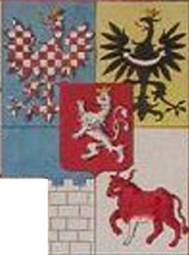
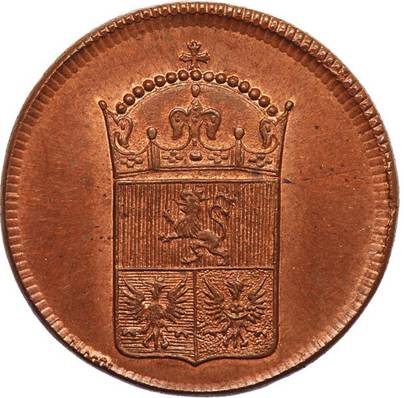
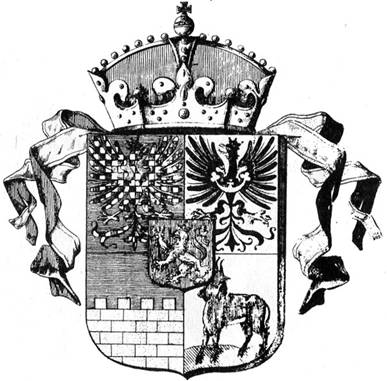
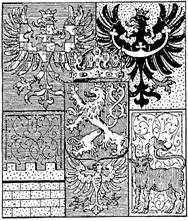
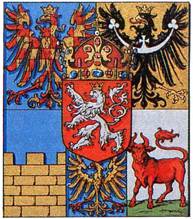
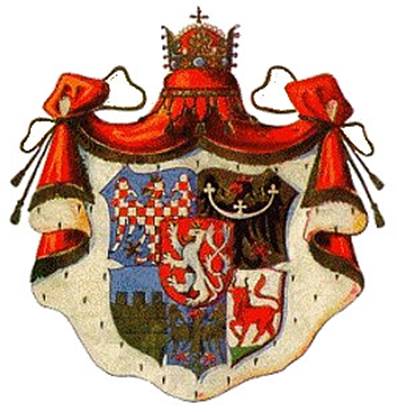
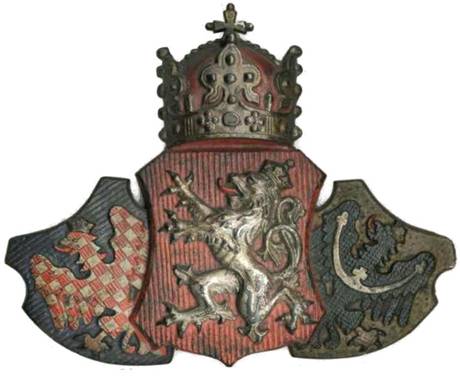
 Heraldry of the World
Heraldry of the World